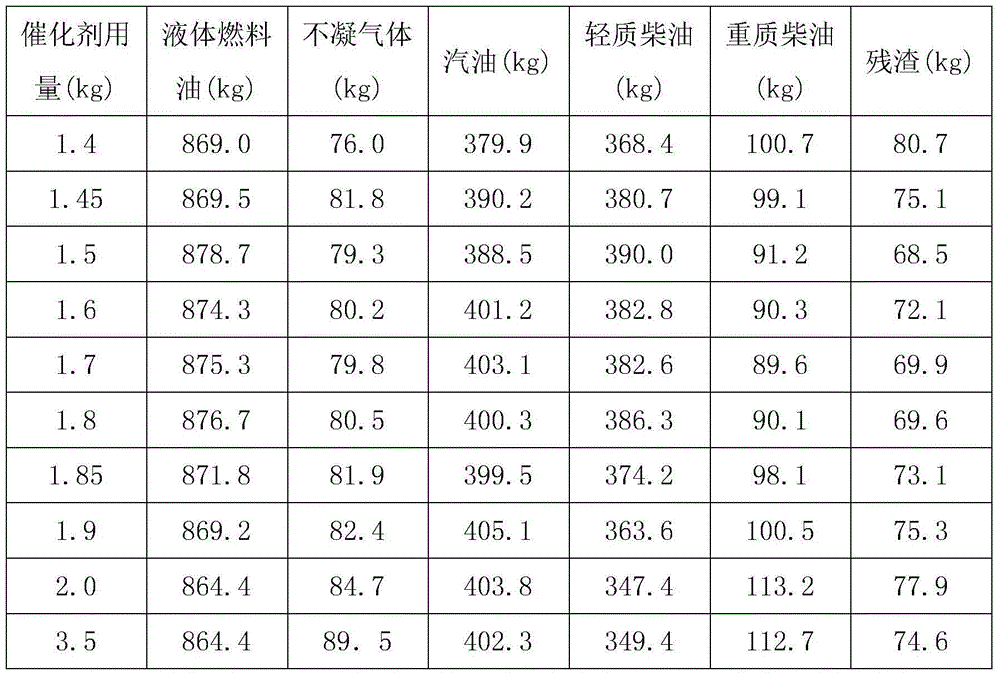Fuel oil preparation technique utilizing waste plastics
A preparation process and a technology for waste plastics, which are applied in the preparation of liquid hydrocarbon mixtures, the petroleum industry, and the treatment of hydrocarbon oil. Reactive contact surface, easy to scale production, and the effect of reducing sticky coking
- Summary
- Abstract
- Description
- Claims
- Application Information
AI Technical Summary
Problems solved by technology
Method used
Image
Examples
Embodiment 1
[0026] (1) Rinse the waste plastic with water and dry it, chop it up, weigh 1000kg, put it into a cracking kettle that can be sealed, add ultra-fine alumina, 1.8kg of magnesium oxide modified rare earth catalyst, and 25kg of quartz sand, stir and mix evenly Finally, connect the cracking tank with the condenser, insert a thermocouple thermometer into the material in the cracking tank, and heat the material at a rate of 5-10°C / min.
[0027] (2) Turn on the temperature controller, control the temperature and heat the material in different temperature ranges to make it react: respectively control the temperature below 180°C, 180-350°C, 350-410°C, when the highest temperature in the temperature range is reached, control Heat at this temperature for about 1 hour to make the reaction proceed slowly, fully condense the cracked gas entering the condenser, and collect condensate at different temperature ranges.
[0028] (3) After the mixed cracking reaction is completed, the collected l...
Embodiment 2
[0032] (1) Rinse the waste plastic with water and dry it, chop it up, weigh 1000kg, put it into a cracking kettle that can be sealed, add ultra-fine alumina, 1.5kg of magnesium oxide modified rare earth catalyst, and 25kg of quartz sand, stir and mix evenly Finally, connect the cracking tank with the condenser, insert a thermocouple thermometer into the material in the cracking tank, and heat the material at a rate of 5-10°C / min.
[0033] (2) Turn on the temperature controller, control the temperature and heat the material in different temperature ranges to make it react: respectively control the temperature below 180°C, 180-350°C, 350-410°C, when the highest temperature in the temperature range is reached, control Heating at this temperature for about 1.5 hours, so that the reaction proceeds slowly, fully condenses the cracked gas entering the condenser, and collects condensate at different temperature ranges.
[0034] (3) After the mixed cracking reaction is completed, the c...
Embodiment 3
[0038] (1) Rinse the waste plastic with water and dry it, chop it up, weigh 1000kg, put it into a cracking kettle that can be sealed, add ultra-fine alumina, 1.6kg of magnesium oxide modified rare earth catalyst, and 25kg of quartz sand, stir and mix evenly Finally, connect the cracking tank with the condenser, insert a thermocouple thermometer into the material in the cracking tank, and heat the material at a rate of 5-10°C / min.
[0039] (2) Turn on the temperature controller, control the temperature and heat the material in different temperature ranges to make it react: respectively control the temperature below 180°C, 180-350°C, 350-410°C, when the highest temperature in the temperature range is reached, control Heating at this temperature for about 1.5 hours, so that the reaction proceeds slowly, fully condenses the cracked gas entering the condenser, and collects condensate at different temperature ranges.
[0040] (3) After the mixed cracking reaction is completed, the c...
PUM
 Login to View More
Login to View More Abstract
Description
Claims
Application Information
 Login to View More
Login to View More - R&D
- Intellectual Property
- Life Sciences
- Materials
- Tech Scout
- Unparalleled Data Quality
- Higher Quality Content
- 60% Fewer Hallucinations
Browse by: Latest US Patents, China's latest patents, Technical Efficacy Thesaurus, Application Domain, Technology Topic, Popular Technical Reports.
© 2025 PatSnap. All rights reserved.Legal|Privacy policy|Modern Slavery Act Transparency Statement|Sitemap|About US| Contact US: help@patsnap.com

